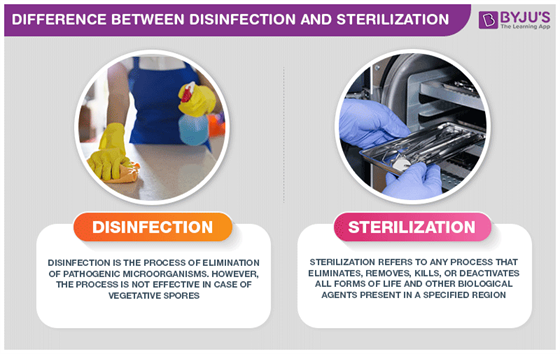Disinfection and sterilization are the two common methods of killing or inhibiting the growth of microorganisms. Microbes can cause a number of diseases in humans and animals. They are also responsible for food spoilage. Therefore, it is beneficial to kill or inhibit their growth to minimize their harmful effects. This is achieved by sterilization or disinfection. However, both these processes are based on different principles.
Let us have a detailed look at the difference between disinfection and sterilization.
Disinfection vs Sterilization
Following are the important difference between disinfection and sterilization:

|
Disinfection |
Sterilization |
| In this, the number of harmful microbes is minimized to a negligible level. |
In this, the medium is made completely free from all microbes. |
|
It kills only vegetative cells and not the spores. |
It kills both vegetative cells and spores. |
| Wounds are disinfected – with agents such as hydrogen peroxide or rubbing alcohol. |
Wounds cannot be sterilized – as it may kill surrounding healthy cells. |
|
Disinfection only reduces the effect of microbes. |
Sterilization completely rids microbes from the surface |
| Chemical methods are used for disinfection |
Combination of heat, irradiation, high pressure, chemical and physical methods are used for sterilization |
|
Phenol, alcohol, chlorine, iodine are some of the disinfecting agents. |
High temperatures, steam, radiation, filtration are some of the sterilization techniques. |
| Only adequate cleanliness |
Extreme cleanliness |
|
Used in daily life. |
Used primarily for medical and research purposes. |
| For eg., pasteurization, disinfecting urinals, etc. |
For eg., sterilization of instruments used during surgery by autoclaving. |
What is Sterilization?
Sterilization is a process mainly used to kill all forms of microorganisms and its spores. This process is carried out to maintain a sterile environment. It is usually done through combinations of heat, irradiation, filtration, high pressure etc.
Read more: Principle of Sterilization
What is Disinfection?
Disinfection is a chemical process used to eliminate or inhibit the growth of bacteria and other pathogens that may cause infectious diseases in humans and animals. Disinfectants are the chemical solutions used to make substance infection-free. These include alcohol, iodine, chlorine, etc.
Similarities Between Disinfection and Sterilization
Disinfection and sterilization have a few things in common. These include:
- Both are used to decontaminate objects and surfaces
- Both processes can kill (most) harmful microbes.
Conclusion
The main takeaway here is that the aim of disinfection and sterilization are different. Disinfection aims to kill or inactivate harmful microorganisms, but leaves some microbes intact. Sterilization, on the other hand, aims at killing all the microbes. And each form of decontamination has its functional use, as stated in the comparison chart.
Also Read:
Register with BYJU’S to learn more about disinfection, sterilization or any other fascinating topics.
Main Page: BYJU’S Biology
Comments